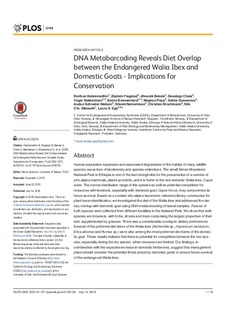DNA metabarcoding reveals diet overlap between the endangered walia ibex and domestic goats - implications for conservation
| dc.contributor.author | Mewicha, Berihun Gebremedhin | |
| dc.contributor.author | Flagstad, Øystein | |
| dc.contributor.author | Bekele, Afework | |
| dc.contributor.author | Gelete, Desalegn Chala | |
| dc.contributor.author | Bakkestuen, Vegar | |
| dc.contributor.author | Boessenkool, Sanne | |
| dc.contributor.author | Popp, Magnus | |
| dc.contributor.author | Gusarova, Galina | |
| dc.contributor.author | Schrøder-Nielsen, Audun | |
| dc.contributor.author | Nemomissa, Sileshi | |
| dc.contributor.author | Brochmann, Christian | |
| dc.contributor.author | Stenseth, Nils Christian | |
| dc.contributor.author | Epp, Laura | |
| dc.date.accessioned | 2016-12-22T09:46:30Z | |
| dc.date.available | 2016-12-22T09:46:30Z | |
| dc.date.created | 2016-10-01T11:45:43Z | |
| dc.date.issued | 2016 | |
| dc.identifier.issn | 1932-6203 | |
| dc.identifier.uri | http://hdl.handle.net/11250/2425747 | |
| dc.description.abstract | Human population expansion and associated degradation of the habitat of many wildlife species cause loss of biodiversity and species extinctions. The small Simen Mountains National Park in Ethiopia is one of the last strongholds for the preservation of a number of afro-alpine mammals, plants and birds, and it is home to the rare endemic Walia ibex, Capra walie. The narrow distribution range of this species as well as potential competition for resources with livestock, especially with domestic goat, Capra hircus, may compromise its future survival. Based on a curated afro-alpine taxonomic reference library constructed for plant taxon identification, we investigated the diet of the Walia ibex and addressed the dietary overlap with domestic goat using DNA metabarcoding of faecal samples. Faeces of both species were collected from different localities in the National Park. We show that both species are browsers, with forbs, shrubs and trees comprising the largest proportion of their diet, supplemented by grasses. There was a considerable overlap in dietary preferences. Several of the preferred diet items of the Walia ibex (Alchemilla sp., Hypericum revolutum, Erica arborea and Rumex sp.) were also among the most preferred diet items of the domestic goat. These results indicate that there is potential for competition between the two species, especially during the dry season, when resources are limited. Our findings, in combination with the expected increase in domestic herbivores, suggest that management plans should consider the potential threat posed by domestic goats to ensure future survival of the endangered Walia ibex. | nb_NO |
| dc.language.iso | eng | nb_NO |
| dc.rights | Navngivelse 4.0 Internasjonal | * |
| dc.rights.uri | http://creativecommons.org/licenses/by/4.0/deed.no | * |
| dc.title | DNA metabarcoding reveals diet overlap between the endangered walia ibex and domestic goats - implications for conservation | nb_NO |
| dc.type | Journal article | nb_NO |
| dc.type | Peer reviewed | nb_NO |
| dc.source.pagenumber | e0159133 | nb_NO |
| dc.source.volume | 11 | nb_NO |
| dc.source.journal | PLoS ONE | nb_NO |
| dc.source.issue | 7 | nb_NO |
| dc.identifier.doi | 10.1371/journal.pone.0159133 | |
| dc.identifier.cristin | 1388668 | |
| dc.relation.project | Norges forskningsråd: 191627 | nb_NO |
| cristin.unitcode | 7511,2,0,0 | |
| cristin.unitcode | 7511,6,0,0 | |
| cristin.unitname | Avdeling for terrestrisk økologi | |
| cristin.unitname | Oslo | |
| cristin.ispublished | true | |
| cristin.fulltext | original | |
| cristin.qualitycode | 1 |
Tilhørende fil(er)
Denne innførselen finnes i følgende samling(er)
-
Publikasjoner fra CRIStin - NINA [2364]
-
Scientific publications [1392]
Vitenskapelige artikler, kapitler og monografier i Open Access.

